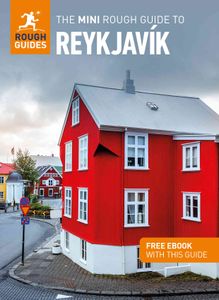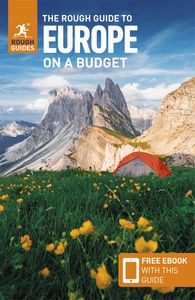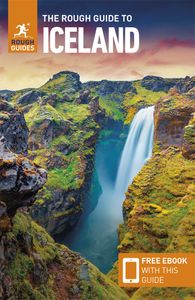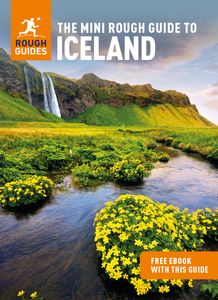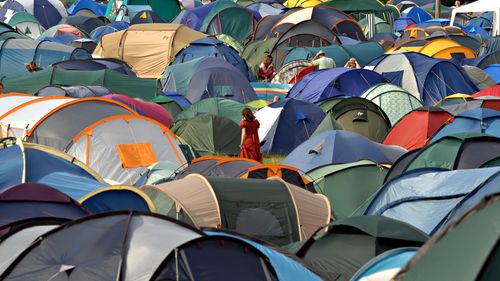Hiking in western Snæfellsnes
Hellissandur makes a good base for exploring the foot of the Snæfellsjökull and the surrounding lavafields. A recommended day hike of around 20km leads from the village to Eysteinsdalur valley; take the unmarked secondary road between the campsite and the maritime museum that leads towards the glacier. After around 1km the road becomes a hiking path which strikes out across the Prestahraun lavafield, joining up after 4km with the unnumbered road that runs up through the valley. Here, on the south side of the road, a signed path leads up to the hill, Rauðhóll, to a red scoria crater. An impressive rift in the lava can also been seen to the east of the hill. Continue another 1km along the road towards the glacier and you’ll come to a signposted path to the south of the road, which leads to the prominent basalt spur, Klukka, and a beautiful waterfall, Klukkufoss, where the Móðulækur river flows through a narrow canyon lined with basalt columns. Back on the main road and another 1km towards the glacier, a path to the north of the road leads to the Blágil ravine, where the Ljósulækir glacial river thunders through the narrow rugged gorge. To return to Hellissandur, retrace your steps along the main road, beyond the turn for the waterfall, to the hiking path that heads out to the north across the Væjuhraun lavafield for Rif. From here, simply head west along the coastal road to Hellissandur. Maps of these routes should be available from the tourist office in Ólafsvík and the hotel in Hellissandur.
Another recommended day hike (18km) leads first to the sandy bay of Skarðsvík, walled in by cliffs and crags on its northern and western edges. The lava above the cliffs is overgrown with moss and can be a good place to see rare plants. Excellent fishing can be had in the bay’s protected waters and it’s therefore a favourite spot for local boats. To get here, follow Route 574 west out of Hellissandur to its junction with the unnumbered road signed for Skarðsvík; it’s at this point that the main road swings inland, heading for the glacier and the turn for Eysteinsdalur valley. Just 2km west of Skarðsvík the road terminates at the peninsula’s westernmost point, Öndverðarnes, a dramatic and weatherbeaten spot marked only by a lonely lighthouse and a stone well which legend has it is linked to three springs: one of fresh water, one of sea water and one of wine. The promontory is a favourite destination for basking seals, which favour the pebbly beach here. South of the cape the Svörtuloft cliffs are worth a visit; swarming with seabirds in summer, the cliffs provided a major source of eggs and birds for the tables of local villagers until the 1950s, when living standards began to rise. The free-standing crag in the sea here, Skálasnagi, was once connected to the mainland by a natural stone bridge until it fell victim to the pounding of Atlantic breakers in 1973. From the cliffs, a path heads east, inland through the Neshraun lavafield to an area of small hillocks known as Neshólar before emerging at Skarðsvík.
Búðir
Nineteen kilometres east of Arnarstapi, Búðir is a romantic, windswept location, a former fishing village at the head of the sweeping expanse of white sand that backs the Búðavík bay. The settlement, like so many others in this part of the country, was abandoned in the early nineteenth century and today consists of nothing more than a hotel and a church, both situated just a stone’s throw from the ocean. Surrounded by the Búðahraun lavafield, rumoured to be home to countless elves, and enjoying unsurpassed views out over the Atlantic, the tiny pitch-black church with its three white-framed windows dates from 1703, and cuts an evocative image when viewed from the adjoining graveyard with the majestic Snæfellsnes mountain range as a backdrop. Look out too for the unusual wall, made of lava and topped with turf, that surrounds the churchyard.
Flatey
The largest of the Breiðafjörður islands, Flatey is a tranquil haven of two dozen or so restored wooden cottages set amid fields that are bright yellow with buttercups in summer. If you like the idea of having nothing to do all day but stroll through undisturbed meadows while taking in magnificent vistas of the West Fjord mountains and Snæfellsjökull, then dining by evening on succulent cod caught the same afternoon, this is the place to come. The weather is most dependable in August, but remember if you’re coming here out of season the island will be virtually deserted, since most of the houses are only occupied in summer by Reykjavík city slickers; just five people spend the winter on Flatey.
Although low-key in the extreme today, Flatey was once one of Iceland’s leading cultural centres, and in 1172 a monastery was founded on the island’s highest point, a little behind where the present-day church stands, though there’s nothing left of it today.
From the ferry jetty it’s a ten-minute walk down the rough track that passes as the island’s one and only road to the old village, a restored collection of painted houses nestling around a tiny harbour. It’s from here that Flatey’s sheep are painstakingly bundled into boats and taken to surrounding islands for summer grazing – quite a sight if you’re around to witness it.
Past the harbour the track bears right, turns into a well-trodden path and climbs a little to the diminutive Lundaberg cliffs where you’ll find plenty of black guillemot, kittiwakes, fulmars and puffins from April onwards; half of all the different species of bird that breed in Iceland are found on the islands of Breiðafjörður.
Flatey’s church, with its dramatic roof, is easily reached by a footpath from the village’s main street. Inside, you’ll see paintings of island life – and puffins – by the Catalan painter Baltasar Samper. Quite the entrepreneur, while visiting the island in the 1960s he suggested painting the church in return for free accommodation; his picture behind the altar shows Christ, unconventionally wearing a traditional Icelandic woolly sweater, standing alongside two local sheep farmers. After much hard work, the yellow building behind the church has been restored to its former glory and proudly claims the title of the oldest and smallest library in Iceland, established in 1864.
Beyond the Lundaberg cliffs, the footpath continues towards the eastern part of the island, which has been declared a nature reserve, marked by the odd sign or two and closed to the public during the breeding season (May 15 to July 20); the birds migrate south in late August or early September. Even during the breeding season, however, it’s possible to walk around the eastern part of the island following the marked wooden posts, to Flatey’s south coast, though the latter is also closed at this time – you can reach it but you cannot walk along it. Here you’ll be bombarded by arctic tern, which show no mercy for man or beast – even the island’s sheep are subject to regular divebombing raids. If you don’t mind this (keeping still seems to deter the birds a little), there are some secluded pebbly coves here, home to the odd wrecked fishing boat, with excellent views on a clear day across to Snæfellsjökull.
Flateyjarbók
Flatey was once home to the Flateyjarbók, a collection of illuminated medieval manuscripts written on 113 calfskins. Although the book was written at Víðidalstunga in northern Iceland around 1387, it somehow turned up on the island and remained in the possession of a local farmer’s family until they gave it to the Bishop of Skálholt, who in turn sent it by royal request to King Frederik III of Denmark in 1659. The Flateyjarbók finally returned to Iceland in 1971 and is today stored in Reykjavík.
Snæfellsjökull
Made world famous in the nineteenth century by Jules Verne’s Journey to the Centre of the Earth, Snæfellsjökull stands guard at the very tip of the peninsula to which it gave its name (Snæfell means “Snow Mountain”; Snæfellsnes means “Snow Mountain Peninsula”). It is from here that Verne’s hero, the German geologist Professor Lidenbrock of Hamburg, descends into a crater in the dormant volcano under the glacier and embarks on a fantastic subterranean journey accompanied by his nephew and an Icelandic guide with the very un-Icelandic name of Hans. The professor has managed to decipher a document written in runic script that leads him to believe that this is the way to the centre of the earth; rather inexplicably he finally emerges on the volcanic Mediterranean island of Strómboli. This remote part of Iceland has long been associated with supernatural forces and mystery, and stories like this only strengthen this belief – at one time the glacier even became a point of pilgrimage for New Age travellers, though they’re not much in evidence today. The 1446m, three-peaked glacier sits on a dormant volcano marked by a large crater, 1km in diameter, with cliff walls 200m high; three eruptions have occurred under the glacier in the past ten thousand years, the last around 250 AD.
Experienced hikers have a choice of ascents, though you’ll probably need ice axes and crampons, and should also first talk to the national park office in Malarrif about the condition of routes and the likely weather. There are two trailheads: either east off the four-wheel-drive-only Route F570, which clips Snæfell’s eastern flank as it runs for 18km between Ólafsvík and Arnarstapi; or at the ice cap’s northwestern corner, via a track running east of Neshraun. Hiking trails cross between these two starting points via the glacier’s apex, Jökulþúfur (1446m), which sits atop three crags on the crater rim – allow at least four hours to make the crossing, not counting the time it takes to reach the trailheads themselves.








